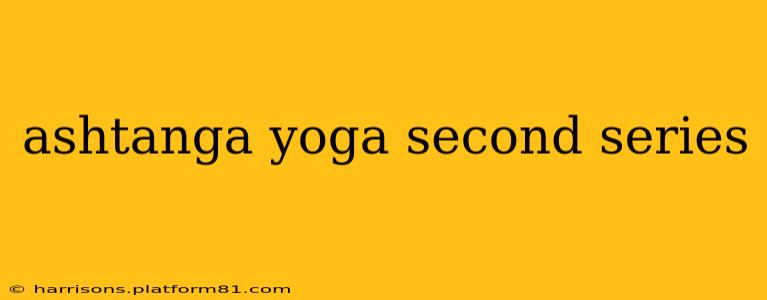Ashtanga Yoga's Second Series, also known as Nadi Shodhana, is a significant milestone in an Ashtanga practitioner's journey. It's a challenging but rewarding progression from the First Series (Yoga Chikitsa), introducing more complex postures and a deeper exploration of the body's energetic pathways (nadis). This deep dive will explore the key aspects of the Second Series, addressing common questions and providing insights for both seasoned practitioners and those considering this next step.
What are the main differences between Ashtanga First and Second Series?
The most noticeable difference lies in the intensity and complexity. The Second Series significantly increases the physical demands, incorporating more arm balances, inversions, and backbends. It also introduces a longer sequence, demanding greater stamina and mental focus. While the First Series focuses on foundational strength and stability, the Second Series builds upon this base, pushing practitioners to explore their limits and deepen their understanding of alignment and breathwork. The transitions between asanas also become more intricate and demanding.
What are some key poses in Ashtanga Second Series?
The Second Series introduces a wealth of challenging and rewarding poses, including:
- Dwi Pada Pichhamattasana (Two-footed backbend): This deep backbend requires significant flexibility and core strength.
- Eka Pada Koundinyasana I & II (One-legged Koundinya's pose): These arm balances demand significant upper body strength, core stability, and a focused mind.
- Natarajasana (Lord of the Dance pose): A challenging balancing pose requiring hip flexibility, core strength, and balance.
- Urdhva Dhanurasana (Upward-facing bow pose or Wheel pose): A powerful backbend that requires significant strength and flexibility throughout the entire body.
- Various variations of handstand and forearm stand: These inversions enhance strength, balance, and self-confidence.
How long does it take to learn Ashtanga Second Series?
There's no set timeframe for mastering the Second Series. The progression depends on individual factors such as prior yoga experience, physical condition, dedication to practice, and the guidance of a qualified teacher. Some practitioners may take several months, while others may require years. Consistent practice, mindful attention to alignment, and proper instruction are crucial. Patience and self-compassion are key.
Is Ashtanga Second Series suitable for beginners?
No, the Second Series is not recommended for absolute beginners. A solid foundation in Ashtanga First Series is essential to build the necessary strength, flexibility, and understanding of the Ashtanga methodology before attempting the Second Series. The increased physical demands could lead to injury without proper preparation.
How do I prepare for Ashtanga Second Series?
Thorough mastery of the First Series is paramount. This includes not just memorizing the sequence but also deeply understanding the alignment, breathwork, and energetic principles of each posture. Building strength, flexibility, and stamina through consistent practice is vital. Working closely with a knowledgeable Ashtanga teacher for guidance and adjustments is crucial to prevent injury and ensure proper alignment.
What are the benefits of practicing Ashtanga Second Series?
The benefits extend beyond the physical. Beyond increased strength, flexibility, and stamina, regular practice can:
- Deepen your understanding of Ashtanga Yoga: The Second Series allows for a more profound exploration of the practice's philosophy and principles.
- Enhance your self-awareness: The challenging postures require intense focus and self-observation, leading to greater self-awareness.
- Increase your mental clarity and focus: The mental discipline required for the sequence enhances concentration and mindfulness.
- Promote emotional balance: The physical and mental demands can promote a sense of calm and inner peace.
The Ashtanga Second Series represents a significant journey in self-discovery and physical mastery. With dedication, patience, and guidance from a qualified teacher, the rewards are immeasurable. Remember, consistency and mindful practice are key to progress.
